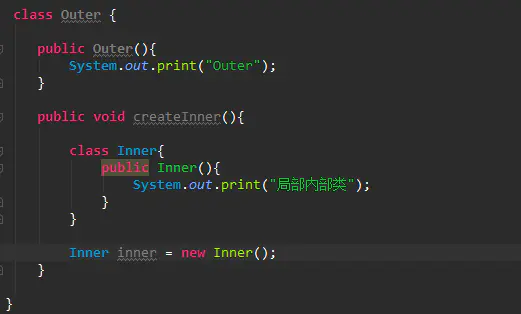In Java, allows the definition of a class is located inside another class, the former is called internal type, which is called an external class.
1. The inner class classification
Members of the inner class (static and non-static) and a local inner class (the method, the code block, the constructor)
2. The members of the inner class to understand
On the one hand, as a member of the outer class:
> Call an external class structure
> can be static modification
> may be modified in four different permissions
On the other hand, as a class:
> Class defines the properties, methods, and other constructors
> final modification may be expressed such can not be inherited. The implication, do not use final, it can be inherited
> abstract may be modified
Features:
- All member properties and methods class members inside unconditional access to the outer class is not private and static influence
- When the property or method members of the same name inside the class and outside the class, hidden phenomenon occurs. Call directly within the class is a member properties and methods within the class. Need "external class" .this. Member variable / method member
- If you need to access the outer class inner class, you need to generate internal objects, to access internal class object.
- Members of the inner class is attached to the outer class existence, if you need to access internal members of the class, then you need to create an external class.
-
As the members of the inner class existence that members of the outer class, so the class can be modified using private public protect modifier modified no authority to represent the problem of access to the internal. The internal and external can not.
public class Test { public static void main (String [] args) { // create a static member within the class object Person.Inner2 Inner2 = new new Person.Inner2 (); // Create a nonstatic member inside the object class Person p = new new the Person (); Person.Inner1 inner1 . = P new new Inner1 (); inner1.show (); // name = Zhang, Age = 23 is inner2.show (); // static member inner class } } class the Person { String name; int Age; // non-static member inner class class{Inner1 public void Show () { name = "Sally" ; Age = 23 is ; System.out.println ( "name =" + name + ", Age =" + Age); } } // static member inner class static class Inner2 { public void Show () { System.out.println ( "static member inner class" ); } } public void eAT () { System.out.println ( "eat" ); } }
3. How to call an external structure of class members inside the class?
class the Person { String name = "Bob" ; public void EAT () { } // non-static member inner class class Bird { String name = "Rhododendron" ; public void the display (String name) { System.out.println (name) ; // shaped process parameters System.out.println ( the this .name); // attribute inner class System.out.println (the Person. the this .name); // attribute outer class // Person.this.eat (); } } }
4. Local inner class
Features:
- You can not use access modifier keywords
- Local action interval within only declared

The anonymous inner classes
Features:
- Anonymous inner classes can not use the static modifier and rights
- Anonymous no internal constructor. By generating a new object reference to XXX.
- Anonymous inner classes belonging to a local inner class, all of the local conditions inside similarly restricted interior remain valid anonymous

Author: Java beauty
Date: 2020-03-30